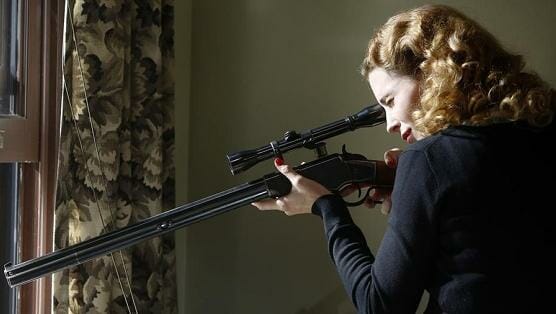Agent Carter has been building to “A Sin to Err” all season long; it’s the moment where the walls have Peggy corralled. She’s pretty much on her own and without a single person, other than Jarvis, to call “friend,” though that more or less sums up her dynamic over the course of the show. But even in the last five episodes, where her male SSR colleagues have ignored her, disdained her, and underestimated her, she has at least had them in her corner in a functional sense. Now, they’re as much her enemies as Dottie and Ivchenko, maybe even more so. Carter has been trained to deal with people like them. She might not be quite so well equipped for an interrogation room chat with her former allies.
“A Sin to Err” feels huge. People die, characters expand, story arcs converge with one another in a confluence of plot; supporting players we previously thought were cast just to add flavor to Agent Carter’s world wind up having stuff to do, though as much as Angie proves a total badass when she covers for Peggy in the SSR raid on the Griffith, she’s better off leaving “A Doll’s House” to professionals. (You can also pat yourself on the back if you predicted that Ivchenko isn’t actually the innocent bystander he claims he is.) There’s simply a lot going on here, which makes up for the one or two series installments that have contented themselves with playing passively instead of making moves.
But the chess game is over, and now Peggy’s in the hot seat. Even Sousa looks at her like she’s a criminal. Sure, yes, technically she is, but we all know that she’s on the right side even if Dooley and Thompson think otherwise. As bad as their judgment might feel to Peggy, it’s likely far more meaningful that Sousa is convinced of her guilt, too. Enver Gjokaj has had some great moments with Hayley Atwell since “Now is Not the End,” bonding through the false inadequacies foisted on them by their coworkers. Sousa’s almost as much of a joke around the department as Peggy, though the respective ignominies they suffer from the other SSR agents come from entirely different places of discourtesy. Peggy’s a woman; in their eyes she’s lesser by her birthright. Sousa’s a cripple; he’s a man, but he’s a pathetic, broken down man. The world has less use for him than for, say, Thompson, who is broken in his own way, but has the benefit of hiding his wounds.
So Sousa and Peggy have connected over the experience of being shunned by their peers, which makes that alleyway moment rather tragic. We can see the struggle of uncertainty play out across Gjokaj’s face in full. Is he more loyal to the SSR than to Peggy? Can he really turn in this person he very obviously cares about? The answer is first “no,” but ultimately “yes,” when Dottie takes Peggy out at the Griffith; more the sucker Peggy for falling for her own trick, though in her defense nobody might reasonably expect Iowa to lock lips with her, even in the best of moments. (Aside: Angie needs to come up with better nicknaming conventions.) The rift between Sousa and Peggy threatens to grow greater next week, but there’s great drama in seeing our favorite member of the SSR after Peggy decide where his priorities lie.
Speaking of that alleyway scene, isn’t it satisfying to see Peggy finally knock Thompson the hell out? Even after the events of “The Iron Ceiling”, Thompson still refuses to respect her abilities as a combatant and as a strategist; if there’s one criticism that can be made of “A Sin to Err,” it’s that it reasonably thinks Thompson should be surprised that Peggy is able to fend off a handful of skilled operatives on her own (save for Jarvis’ contributions to the scuffle). It’s a great sequence from the diner to the streets. Like “The Iron Ceiling,” it’s a reminder to audiences that Agent Carter is about more than just intrigue and spycraft. Sometimes, espionage just goes from scheming to fisticuffs, and when it does it’s nice to see the action handled this crisply.
“A Sin to Err” is terrific television, orchestrating two different manhunts (or womanhunts, if you want to be specific) in tandem with one another with brio. That it ends with Peggy in handcuffs is the sly, blackly comic punchline to her efforts to find out the identity of the Russian assassin, who’s no stranger to handcuffs herself. And that final line from Dooley is icing on the cliffhanger cake, proof that sexism is her worst opponent, more than foreign killers and genius hypnotists. The deck is stacked against Peggy more than ever now. She’s going to have to play her cards perfectly to come out ahead.
Boston-based critic Andy Crump has been writing about film for the web since 2009, and has been contributing to Paste Magazine since 2013. He also writes for Screen Rant and Movie Mezzanine. You can follow him on Twitter. Currently, he has given up on shaving.
